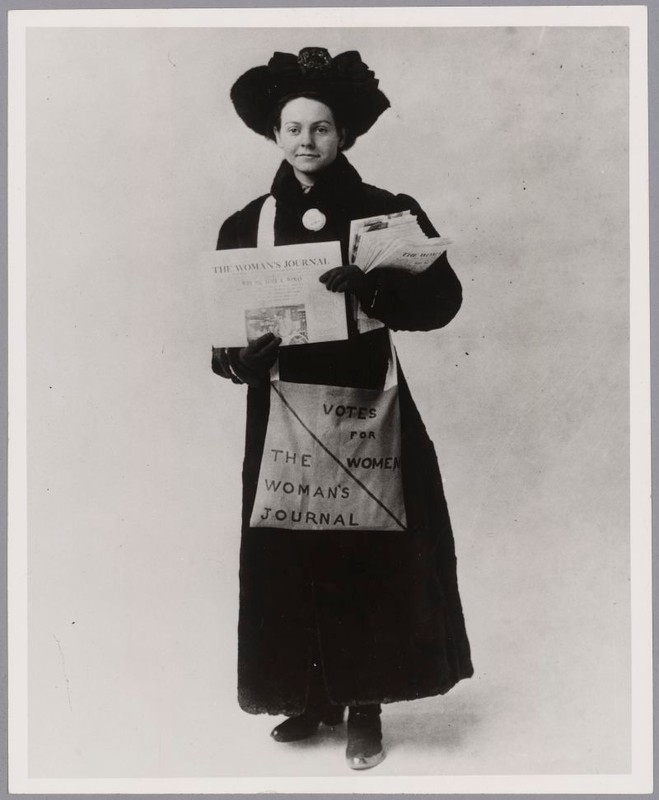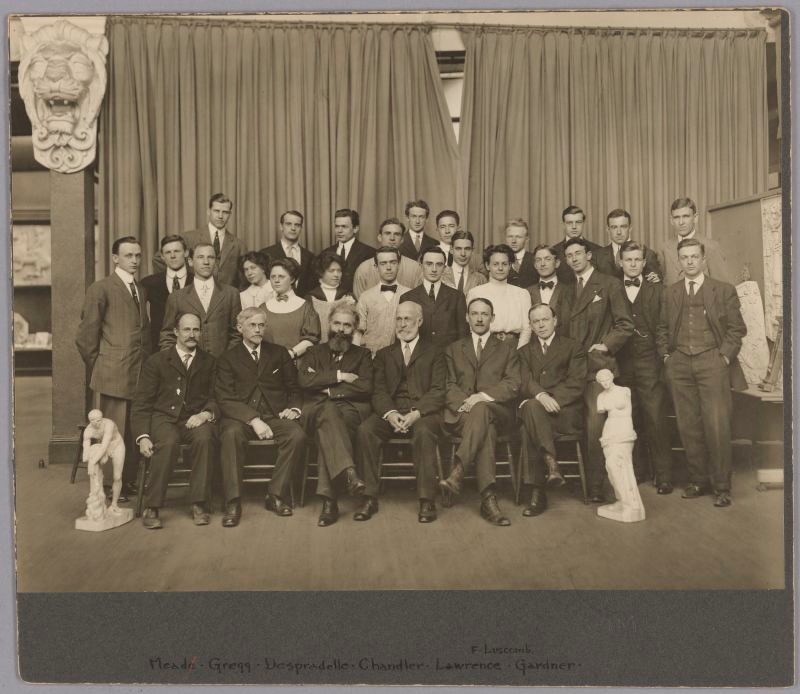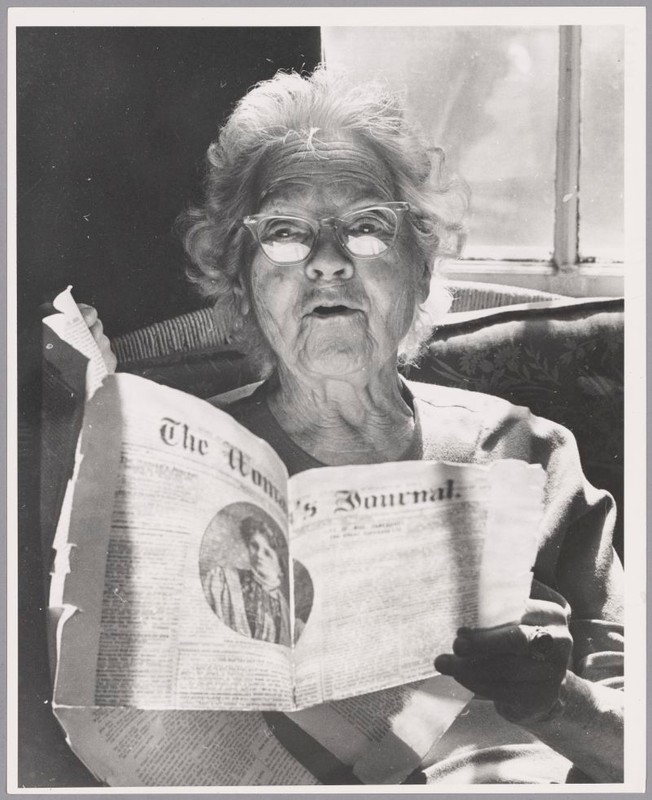Corner of Tremont & Winter Streets - Florence Luscomb Winning Freedom & Justice for Half the Human Race
Introduction
Text-to-speech Audio
Taken on the corner of Tremont and Winter, the picture of Florence Hope Luscomb selling the Woman’s Journal is one of the most iconic pictures of the women’s suffrage movement. The photographer may not have realized how symbolic it would become. Florence had grown up with the movement and started attending suffrage meetings with her mother when she was five. In July 1909, just one month after graduating from the Massachusetts Institute of Technology with an S.B. in Architecture, she debuted as a speaker for the groundbreaking Votes for Women open-air campaign that would conduct 97 public meetings to an estimated 24,900 people across Massachusetts. Over the next decade, Florence would become one of the most influential speakers for the women’s suffrage movement, leaving a profound and lasting impact on the cause.
Images
Full length photograph of Florence Hope Luscomb holding copies of The Woman's Journal. Original Credit Line: The MIT Museum.

MIT School of Architecture class, 1909. Florence Hope Luscomb stands second row, fifth from right.

Florence Hope Luscomb holds a copy of The Woman's Journal. (circa 1980)

Florence Hope Luscomb speaks at Ellen Swallow Richards Lobby dedication. Portrait painting of Ellen Swallow Richards visible at top of stairs. (1979)

Backstory and Context
Text-to-speech Audio
At a time when society believed it improper for a woman to campaign publicly, Florence's courage and strength shone through. “At the busiest hour of the day yesterday shoppers and matinee-goers were surprised to see at the corner of Tremont and Winter [Streets] an attractive young woman selling copies of the Woman’s Journal [...] the young woman who proved herself more courageous than her sisters in the equal suffrage movement was Miss Florence Luscomb of Alston.”13 She sold 10 copies at 5 cents each in 25 minutes. The Woman’s Journal was among the most widely circulated women’s suffrage papers. Its first offices occupied rooms at Tremont Place. Later office locations included Park Street, Beacon Street, and Boylston Street. Florence holds the January 6, 1912 edition with the headline, “Why Not Elect a Woman?”15
Florence recalls, “Mother never tried to dictate what I should believe in. But I went to meetings with her, she exposed me to thoughts, she had leaflets, she had reading matter around for me to read if I wanted to.”3 She accompanied her mother, Hannah Luscomb, an outspoken advocate for the women's suffrage and labor movements, to the National American Woman Suffrage Association convention in 1892: “And I heard Susan B. Anthony speak and that was my start in the women’s suffrage movement.”7
Born in Boston in 1887, Florence attended grammar and high school at Chauncy Hall, a preparatory school for MIT. “All my boy classmates were going to MIT - why shouldn’t I go?”3 From articles in The Tech, MIT’s student newspaper, Florence participated in various class and department activities. Florence joined Cleofan, MIT’s first female student club, and the College Equal Suffrage League. After graduation, she often returned to MIT through 1980 to speak about the history of women’s suffrage as well as current issues for women’s rights and to support the progressive movement.8
The gender discrimination women faced in education, work, and pay opportunities further galvanized Florence’s activism for women’s rights. Within weeks of graduating from MIT in 1909, Florence joined the Votes for Women open-air campaign. Florence addressed crowds at open-air meetings and handed out leaflets at country fairs. For their final stop in September 1909, the Votes for Women Committee had planned a parade to the Boston Common, but the final push left the women a bit weary. Nevertheless, they found a way to make it interesting. Accompanied by Rosa Heinzen, Florence Luscomb arrived at the Boston Common's Charles St. Mall with a yellow banner, led a "small assembly." on a march to the corner of Boylston St., and planted their banner. Standing atop an overturned trash barrel, Florence addressed a crowd of 2000. Despite her success as a speaker, Florence needed to earn a living. In 1912, Ida Annah Ryan, the first woman to earn an S.M. in Architecture in 1905 from MIT, hired Florence and allowed her time off to promote women's suffrage.5,12
Florence’s influence expanded beyond Massachusetts. She went on to participate in countless rallies, meetings, and conferences across the U.S. In 1911, the Massachusetts Woman’s Suffrage Association (MWSA) and the Boston Equal Suffrage Association for Good Government (BESAGG) funded a trip for Florence Luscomb and Margaret Foley to travel to learn about the British suffrage movement and attend the International Woman Suffrage Alliance convention on June 13-17, in Stockholm, Sweden. In London, they participated in a “suffrage parade and demonstration at Albert Hall in London” - the 1911 Suffragette Women's Coronation Procession, organized to garner support from the soon-to-be-coronated King George V. With 40,000 marchers, it was one of the largest suffrage demonstrations. Florence and Margaret would go on to organize and march in other demonstrations, including the 1914 & 1915 Boston Suffrage parades. 2,12,14,16
After the 19th Amendment, BESAGG and CESL merged with the Boston League of Women Voters. During these early years, Florence developed a handbook for voters. Although never elected, Florence also ran for various public offices during her lifetime.
In 1973, Florence was a featured speaker at the Nixon Counter-Inauguration demonstration at City Hall Plaza.11 The march started at Park Street, near where she had sold the Woman’s Journal sixty years before. A few years later, campaigning for the passage of the Equal Rights Amendment (ERA), she declared, “It is our job to carry on the making of history - of winning freedom and justice for half the human race.”9 Florence's commitment to social reform was unwavering, advocating for women's rights, civil rights, labor, and peace well into her 90s.
In a speech following the success of the first Votes for Women Open-air Campaign, Florence remarked, “If they are uninterested it is because you have not made it interesting. Make it so. Make it picturesque [...] make it easy.”6 Florence certainly “made it interesting.”
Cite This Entry
Smith, Coleen. "Corner of Tremont & Winter Streets - Florence Luscomb Winning Freedom & Justice for Half the Human Race." Clio: Your Guide to History. August 19, 2024. Accessed April 14, 2025. https://theclio.com/entry/183993
Sources
- ben-Aaron ’85, Diana. “Florence Luscomb, 1887-1985, A Century of Commitment.” MIT Technology Review, February/March, Massachusetts Institute of Technology, 1986.
- “Boston Suffragettes Sail for Europe.” The Boston Globe, 6 Apr. 1911.
- Cantarow, Ellen, et al. Moving the Mountain. Feminist Press at CUNY, 1980.
- “Corner of Tremont and Winter Streets (U.S. National Park Service).” NPS.Gov Homepage (U.S. National Park Service), https://www.nps.gov/places/tremont-and-winter.htm. Accessed 21 July 2024.
- “Fail to Convert C.R. Saunders.” Boston Evening Transcript, 3 Sept. 1909.
- “Florence Luscomb Papers in the Woman’s Rights Collection. Suffrage Materials by Florence Luscomb, 1909-1920, 1945, n.d. WRC, Folder 635.” Schlesinger Library, Radcliffe Institute, Harvard University, Cambridge, Mass., https://nrs.lib.harvard.edu/urn-3:rad.schl:37685995. Accessed 4 Mar. 2024.
- “Luscomb Recalls Pre-Suffrage Days.” Naugatuck Daily News, 29 Aug. 1977.
- “MIT’s The Tech Newspaper [Archive].” Internet Archive: Digital Library of Free & Borrowable Books, Movies, Music & Wayback Machine, 2024, https://archive.org/details/mit_the_tech?tab=collection&query=Luscomb&sin=TXT&sort=title.
- Mulroney, Kate. “Need for a Mass. ERA Declared.” The Tech, Vol. 96, Issue 37, 15 Oct. 1976. Internet Archive: Digital Library of Free & Borrowable Books, Movies, Music & Wayback Machine, https://archive.org/details/mit_the_tech_newspaper-v96-i37/mode/1up.
- Nowogrodzki, SM ’15, Anna. “I Burned with Indignation.” MIT Technology Review, Massachusetts Institute of Technology, Oct. 2020, https://www.technologyreview.com/2020/10/20/1009365/i-burned-with-indignation/.
- Schindler, Paul. “70,000 Protest Second Term.” The Tech, Vol. 92, Issue 58, 23 Jan. 1973. Internet Archive: Digital Library of Free & Borrowable Books, Movies, Music & Wayback Machine, https://archive.org/details/mit_the_tech_newspaper-v92-i58/page/n1/mode/1up.
- Strom, Sharon Hartman. Political Woman. Temple University Press, 2001.
- “Tech Woman Sells Papers.” The Boston Globe, 23 Jan. 1910.
- “What Was the 1911 Suffragette Women’s Coronation Procession? | Museum of London.” Museum of London, Museum of London, 17 Apr. 2023, https://web.archive.org/web/20240723213826/https://www.museumoflondon.org.uk/discover/what-was-1911-suffragette-womens-coronation-procession.
- “Why Not Elect a Woman?” Woman’s Journal, 6 Jan. 1912.
- “Woman’s Suffrage Delegates.” Rutland Daily Herald, 23 Mar. 1911.
1. Florence & Woman's Journal: Courtesy of the MIT Museum, https://mitmuseum.mit.edu/collections/object/GCP-00016736
2. Class of 1909: Courtesy of the MIT Museum, https://mitmuseum.mit.edu/collections/object/GCP-00016786
3. Florence w/Newspaper: Courtesy of the MIT Museum, https://mitmuseum.mit.edu/collections/object/GCP-00016777
4. Florence Speaking: Calvin Campbell. Courtesy of the MIT Museum, https://mitmuseum.mit.edu/collections/object/GCP-00016783.

